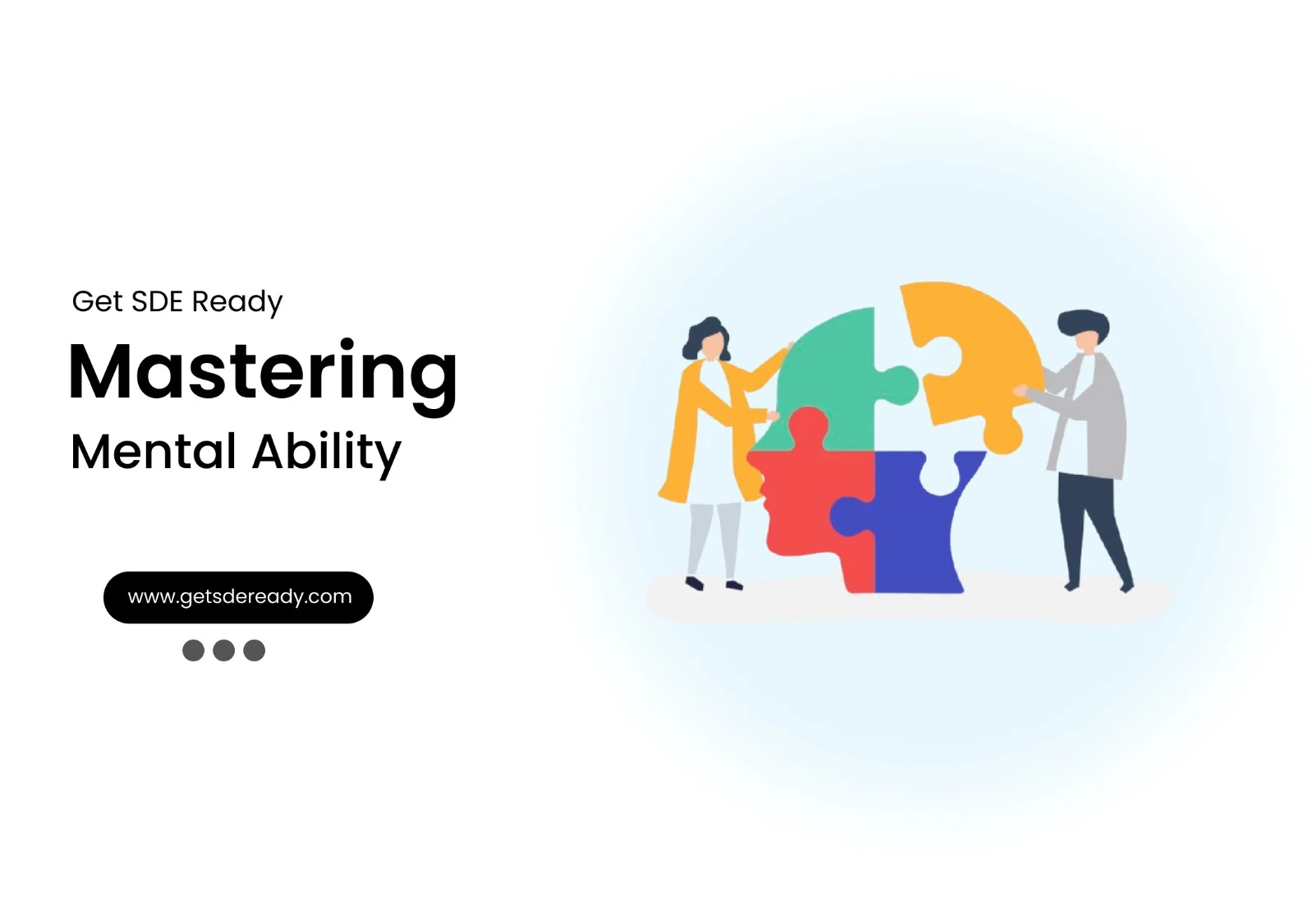Data Structures and Algorithms
- Introduction to Data Structures and Algorithms
- Time and Space Complexity Analysis
- Big-O, Big-Theta, and Big-Omega Notations
- Recursion and Backtracking
- Divide and Conquer Algorithm
- Dynamic Programming: Memoization vs. Tabulation
- Greedy Algorithms and Their Use Cases
- Understanding Arrays: Types and Operations
- Linear Search vs. Binary Search
- Sorting Algorithms: Bubble, Insertion, Selection, and Merge Sort
- QuickSort: Explanation and Implementation
- Heap Sort and Its Applications
- Counting Sort, Radix Sort, and Bucket Sort
- Hashing Techniques: Hash Tables and Collisions
- Open Addressing vs. Separate Chaining in Hashing
- DSA Questions for Beginners
- Advanced DSA Questions for Competitive Programming
- Top 10 DSA Questions to Crack Your Next Coding Test
- Top 50 DSA Questions Every Programmer Should Practice
- Top Atlassian DSA Interview Questions
- Top Amazon DSA Interview Questions
- Top Microsoft DSA Interview Questions
- Top Meta (Facebook) DSA Interview Questions
- Netflix DSA Interview Questions and Preparation Guide
- Top 20 DSA Interview Questions You Need to Know
- Top Uber DSA Interview Questions and Solutions
- Google DSA Interview Questions and How to Prepare
- Airbnb DSA Interview Questions and How to Solve Them
- Mobile App DSA Interview Questions and Solutions
DSA Interview Questions
- DSA Questions for Beginners
- Advanced DSA Questions for Competitive Programming
- Top 10 DSA Questions to Crack Your Next Coding Test
- Top 50 DSA Questions Every Programmer Should Practice
- Top Atlassian DSA Interview Questions
- Top Amazon DSA Interview Questions
- Top Microsoft DSA Interview Questions
- Top Meta (Facebook) DSA Interview Questions
- Netflix DSA Interview Questions and Preparation Guide
- Top 20 DSA Interview Questions You Need to Know
- Top Uber DSA Interview Questions and Solutions
- Google DSA Interview Questions and How to Prepare
- Airbnb DSA Interview Questions and How to Solve Them
- Mobile App DSA Interview Questions and Solutions
Data Structures and Algorithms
- Introduction to Data Structures and Algorithms
- Time and Space Complexity Analysis
- Big-O, Big-Theta, and Big-Omega Notations
- Recursion and Backtracking
- Divide and Conquer Algorithm
- Dynamic Programming: Memoization vs. Tabulation
- Greedy Algorithms and Their Use Cases
- Understanding Arrays: Types and Operations
- Linear Search vs. Binary Search
- Sorting Algorithms: Bubble, Insertion, Selection, and Merge Sort
- QuickSort: Explanation and Implementation
- Heap Sort and Its Applications
- Counting Sort, Radix Sort, and Bucket Sort
- Hashing Techniques: Hash Tables and Collisions
- Open Addressing vs. Separate Chaining in Hashing
- DSA Questions for Beginners
- Advanced DSA Questions for Competitive Programming
- Top 10 DSA Questions to Crack Your Next Coding Test
- Top 50 DSA Questions Every Programmer Should Practice
- Top Atlassian DSA Interview Questions
- Top Amazon DSA Interview Questions
- Top Microsoft DSA Interview Questions
- Top Meta (Facebook) DSA Interview Questions
- Netflix DSA Interview Questions and Preparation Guide
- Top 20 DSA Interview Questions You Need to Know
- Top Uber DSA Interview Questions and Solutions
- Google DSA Interview Questions and How to Prepare
- Airbnb DSA Interview Questions and How to Solve Them
- Mobile App DSA Interview Questions and Solutions
DSA Interview Questions
- DSA Questions for Beginners
- Advanced DSA Questions for Competitive Programming
- Top 10 DSA Questions to Crack Your Next Coding Test
- Top 50 DSA Questions Every Programmer Should Practice
- Top Atlassian DSA Interview Questions
- Top Amazon DSA Interview Questions
- Top Microsoft DSA Interview Questions
- Top Meta (Facebook) DSA Interview Questions
- Netflix DSA Interview Questions and Preparation Guide
- Top 20 DSA Interview Questions You Need to Know
- Top Uber DSA Interview Questions and Solutions
- Google DSA Interview Questions and How to Prepare
- Airbnb DSA Interview Questions and How to Solve Them
- Mobile App DSA Interview Questions and Solutions
CSS in 2025: Latest Features and Techniques You Must Know
CSS has transformed from a basic styling tool into a robust language that powers modern web design. In 2025, new features and techniques are making it easier than ever to create responsive, performant, and visually appealing websites. Whether you’re a beginner or an experienced developer, staying updated with these advancements is key to building cutting-edge web experiences. To deepen your skills or stay informed about the latest web development trends, sign up for our free courses or updates. Let’s explore the top CSS features and techniques you need to know in 2025.
Key CSS Features in 2025
1. Container Queries
Container Queries are revolutionizing responsive design by allowing styles to adapt based on the size of a parent container, rather than the viewport. This makes components like cards or sidebars reusable across different layouts, reducing the need for complex media queries.
- Benefits:
- Reusability: Components adapt to their container, not just the screen size.
- Flexibility: Simplifies responsive design for nested or modular layouts.
- Reduced Code Bloat: Fewer media queries mean cleaner stylesheets.
- Browser Support: Supported by 84.73% of browsers as of March 2025.
Example:
.card {
container-type: inline-size;
}
@container (min-width: 500px) {
.card-content {
display: flex;
gap: 1rem;
}
}
- This code adjusts the .card-content layout when the .card container is at least 500px wide, making it ideal for reusable components.
2. Cascade Layers
Cascade Layers allow developers to organize styles into distinct layers (e.g., base, components, utilities), providing better control over specificity and preventing style conflicts. This is particularly useful for large projects or design systems.
- Benefits:
- Predictable Styling: Layers define a clear order for style application.
- Maintainability: Simplifies debugging and style management.
- Scalability: Ideal for collaborative projects and frameworks.
- Browser Support: 95.08% as of March 2025.
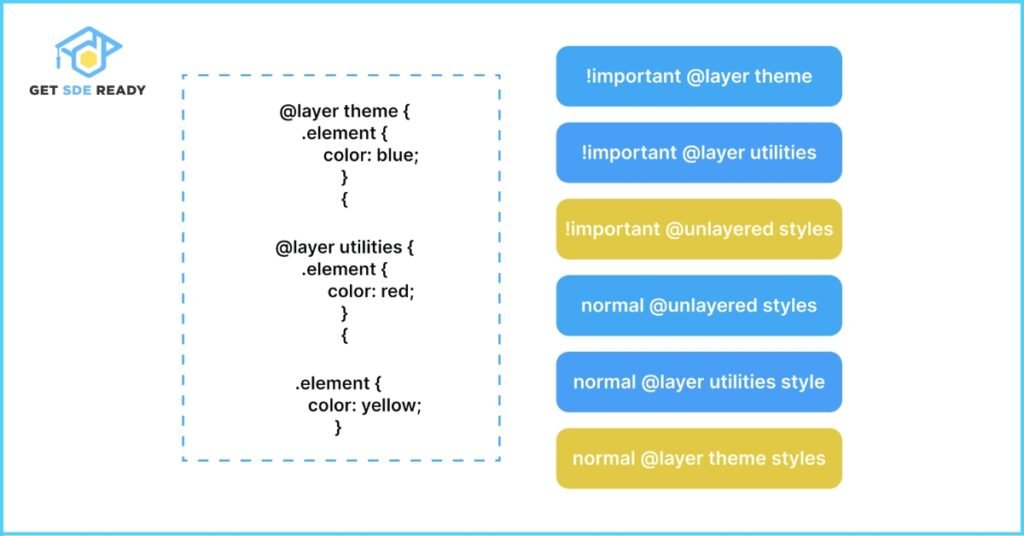
- Example:
@layer base {
body {
font-family: system-ui, sans-serif;
}
}
@layer components {
.button {
padding: 1rem 2rem;
color: white;
background: black;
}
}
- Here, base styles are applied before components, ensuring predictable overrides.
3. @property
The @property rule enhances CSS custom properties by allowing developers to define their syntax, initial values, and inheritance behavior. This makes variables more robust, especially for animations and design tokens.
- Benefits:
- Type Safety: Ensures variables adhere to specific formats (e.g., angles, colors).
- Animatable Properties: Enables smooth transitions for custom properties.
- Design Systems: Supports reusable and consistent design tokens.
- Browser Support: Widely supported in 2025.
Example:
@property --angle {
syntax: '<angle>';
initial-value: 0deg;
inherits: false;
}
.loader {
transform: rotate(var(--angle));
animation: spin 2s linear infinite;
}
@keyframes spin {
to { --angle: 360deg; }
}
- This defines an animatable –angle property for a rotating loader.
4. content-visibility
The content-visibility property optimizes rendering by skipping off-screen content until it enters the viewport, improving performance on long pages or infinite scroll layouts.
- Benefits:
- Faster Load Times: Reduces initial rendering time.
- Lower Memory Usage: Defers rendering of non-visible content.
- Enhanced User Experience: Prioritizes visible content for quicker interactions.
- Browser Support: 89.47% as of March 2025.
Example:
.lazy-section {
content-visibility: auto;
contain-intrinsic-size: 500px;
}
- This ensures .lazy-section is only rendered when it comes into view, boosting performance.
5. Scroll Snap
Scroll Snap creates smooth, controlled scrolling experiences by snapping content to specific points, ideal for galleries, carousels, or single-page applications.
- Benefits:
- Improved Navigation: Guides users through content seamlessly.
- No JavaScript Required: Pure CSS solution for scrolling effects.
- Enhanced UX: Creates polished, app-like scrolling behavior.
- Browser Support: 97.18% as of March 2025.
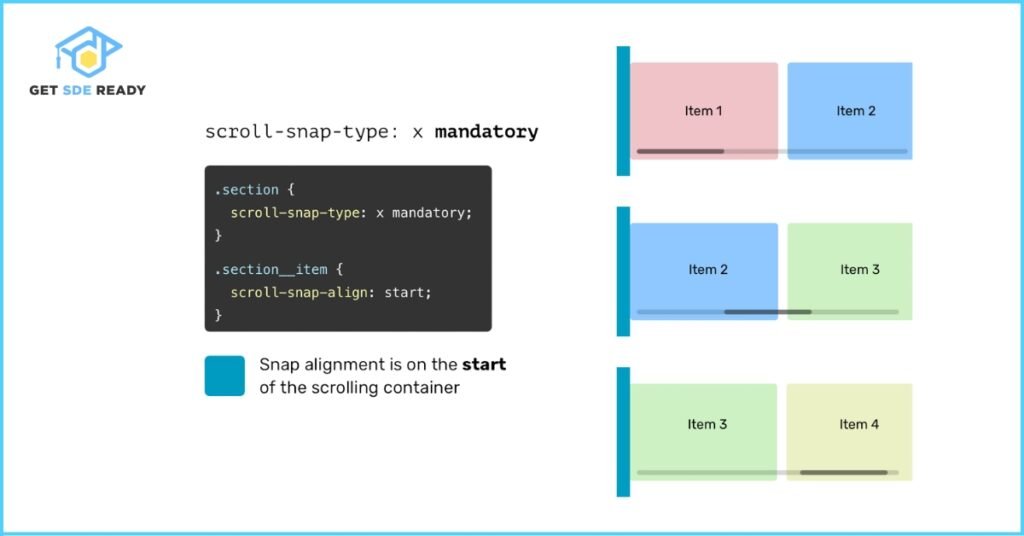
Example:
.scroll-container {
scroll-snap-type: y mandatory;
overflow-y: scroll;
height: 100vh;
}
.scroll-item {
scroll-snap-align: start;
}
- This snaps each .scroll-item into place during vertical scrolling.
6. New Color Palettes
CSS in 2025 supports advanced color spaces like HWB (Hue, Whiteness, Blackness), LAB, and LCH, offering precise control over colors for better design and accessibility.
- Benefits:
- Design Flexibility: More options for creating vibrant color schemes.
- Accessibility: Easier to achieve high-contrast ratios.
- Modern Aesthetics: Aligns with current design trends.
- Browser Support: HWB: 94.3%, LCH: 92.81% as of March 2025.
Example:
.element {
background-color: hwb(210 20% 20% / 0.5);
}
- This applies a semi-transparent blue background using HWB.
7. Variable Fonts
Variable Fonts combine multiple font styles and weights into a single file, reducing file size and offering greater typographic flexibility.
- Benefits:
- Performance: Smaller font files improve load times.
- Design Versatility: Access to a range of weights and styles.
- Accessibility: Supports dynamic typography adjustments.
- Browser Support: 96.64% as of March 2025.

Example:
@font-face {
font-family: 'MyFont';
src: url('myfont.woff2') format('woff2-variations');
}
.text {
font-family: 'MyFont';
font-variation-settings: 'wght' 700, 'ital' 1;
}
- This applies a bold, italicized style from a variable font.
8. Animation Composition
Animation Composition allows multiple animations to be layered additively, enabling complex effects without JavaScript.
- Benefits:
- Rich Interactions: Combine animations for dynamic visuals.
- Performance: Lightweight, CSS-based animations.
- Simplified Code: Reduces reliance on external libraries.
- Browser Support: Supported in major browsers in 2025.
Example:
.spinner {
animation: spin 2s linear infinite, pulse 2s ease-in-out infinite;
animation-composition: add;
}
@keyframes spin {
to { transform: rotate(360deg); }
}
@keyframes pulse {
50% { transform: scale(1.2); }
}
- This combines spinning and pulsing animations for a dynamic effect.
9. Relative Color Syntax & light-dark()
Relative Color Syntax and the light-dark() function enable dynamic color adjustments based on user preferences, such as light or dark mode.
- Benefits:
- Theming: Seamlessly adapts to user color schemes.
- Accessibility: Ensures readable colors in all modes.
- Efficiency: Simplifies theme management.
- Browser Support: Fully supported in 2025.
Example:
.element {
color: light-dark(black, white);
}
- This sets the text color to black in light mode and white in dark mode.
10. Exclusive Accordions
Using HTML <details> elements, developers can create mutually exclusive accordions without JavaScript, simplifying interactive UI components.
- Benefits:
- No JavaScript: Reduces code complexity.
- Accessibility: Built-in support for keyboards and screen readers.
- Ease of Use: Simple to implement and maintain.
- Browser Support: Fully supported in 2025.
Example:
<details name="accordion">
<summary>Section 1</summary>
<p>Content for Section 1</p>
</details>
<details name="accordion">
<summary>Section 2</summary>
<p>Content for Section 2</p>
</details>
- The name attribute ensures only one <details> is open at a time.
Advanced Techniques
1. offset-position & offset-path
These properties enable elements to animate along custom paths, creating sophisticated motion graphics for interactive designs.
- Benefits:
- Dynamic Animations: Move elements along complex paths.
- Engagement: Enhances user interaction with creative visuals.
- Performance: CSS-based animations are lightweight.
- Browser Support: Fully supported in 2025.
Example:
.element {
offset-path: path('M10 10 Q 95 10, 50 90');
offset-distance: 0%;
animation: move 5s linear infinite;
}
@keyframes move {
to { offset-distance: 100%; }
}
- This animates an element along a quadratic curve path.
Practical Applications and Tips
To make the most of these features, consider the following:
- Test Browser Compatibility: Use tools like LambdaTest to ensure cross-browser support.
- Start Small: Experiment with features like Container Queries in small projects before scaling up.
- Combine Features: Use Cascade Layers with CSS Variables for modular, maintainable code.
- Optimize Performance: Leverage content-visibility for long pages to reduce load times.
- Stay Updated: Follow resources like CSS-Tricks for the latest CSS developments.
For a deeper dive into web development, explore our Master DSA, Web Dev, System Design Course or try our Crash Course for a quick skill boost.
Conclusion
CSS in 2025 is a powerhouse of innovation, offering tools to create responsive, performant, and visually stunning websites. Features like Container Queries, Cascade Layers, and content-visibility streamline development, while Variable Fonts and new color palettes unlock creative possibilities. By mastering these techniques, you can build websites that stand out in a competitive digital landscape.
Ready to elevate your skills? Enroll in our Web Development Course or explore our Data Science Course for a broader tech skillset. Stay curious, experiment with these features, and shape the future of web design!
FAQs
What are Container Queries, and how do they differ from Media Queries?
Container Queries apply styles based on a parent container’s size, unlike Media Queries, which rely on viewport size. This makes components more reusable and adaptive across layouts.
How can Cascade Layers improve my CSS organization?
Cascade Layers group styles into defined layers, reducing specificity conflicts and making large projects or design systems easier to manage.
What is the @property rule and why is it useful?
The @property rule defines custom properties with specific syntax and behavior, enhancing CSS variables for animations and consistent design tokens.
How does content-visibility improve website performance?
Content-visibility skips rendering off-screen content until it’s visible, reducing load times and memory usage, especially on long pages.
What are Variable Fonts and how can they benefit my designs?
Variable Fonts combine multiple styles in one file, reducing file size and offering flexible typography for better performance and design.
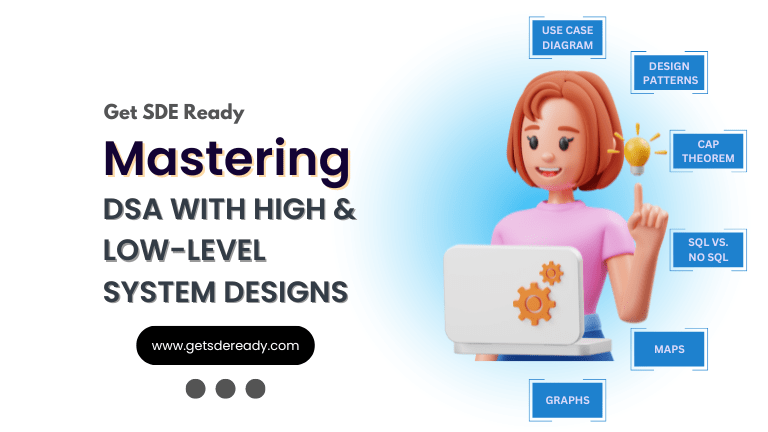
DSA, High & Low Level System Designs
- 85+ Live Classes & Recordings
- 24*7 Live Doubt Support
- 400+ DSA Practice Questions
- Comprehensive Notes
- HackerRank Tests & Quizzes
- Topic-wise Quizzes
- Case Studies
- Access to Global Peer Community
Buy for 52% OFF
₹25,000.00 ₹11,999.00
Accelerate your Path to a Product based Career
Boost your career or get hired at top product-based companies by joining our expertly crafted courses. Gain practical skills and real-world knowledge to help you succeed.
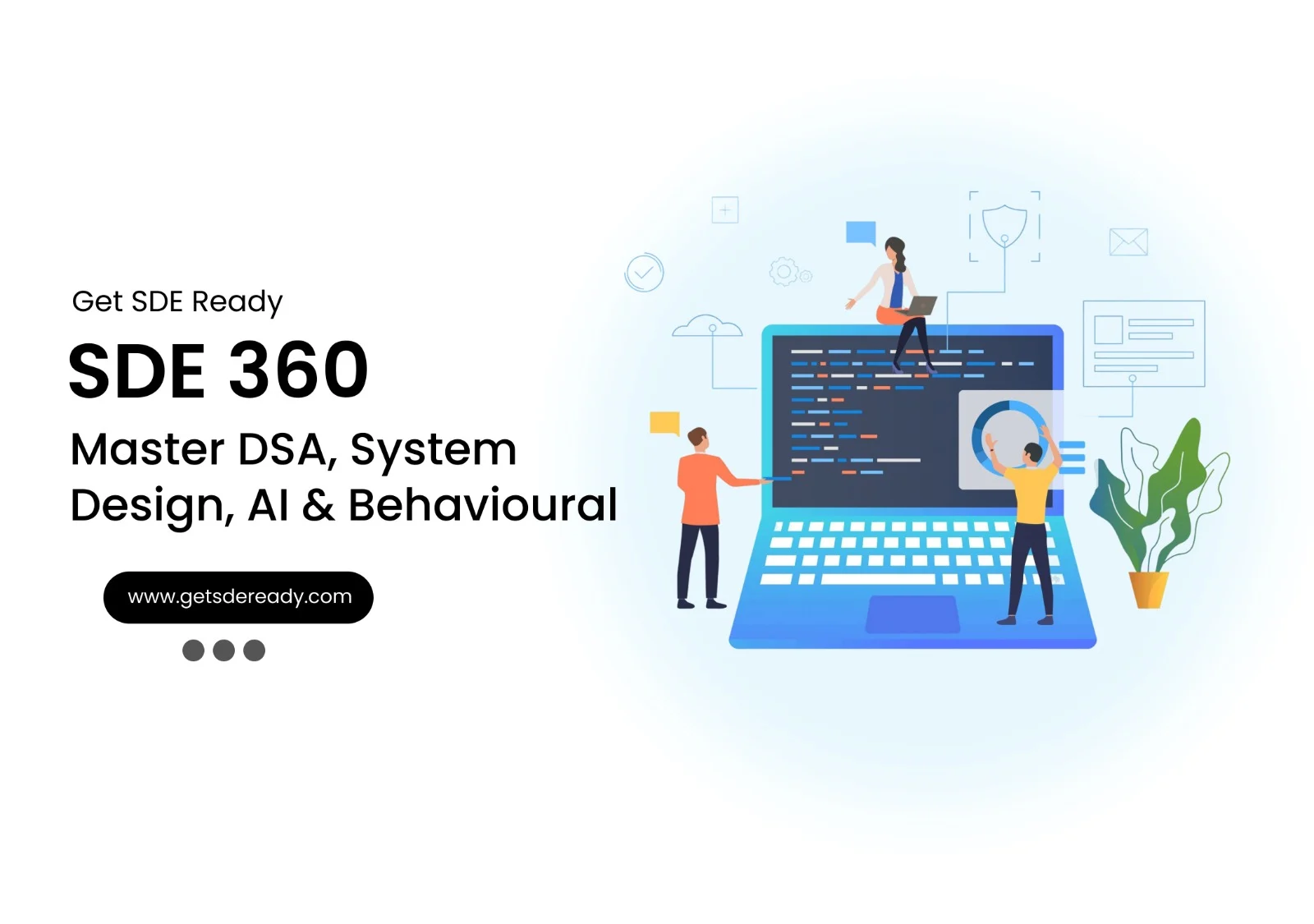
SDE 360: Master DSA, System Design, AI & Behavioural
- 100+ Live Classes & Recordings
- 24*7 Live Doubt Support
- 400+ DSA Practice Questions
- Comprehensive Notes
- HackerRank Tests & Quizzes
- Topic-wise Quizzes
- Case Studies
- Access to Global Peer Community
Buy for 50% OFF
₹39,999.00 ₹19,999.00

DSA, High & Low Level System Designs
- 85+ Live Classes & Recordings
- 24*7 Live Doubt Support
- 400+ DSA Practice Questions
- Comprehensive Notes
- HackerRank Tests & Quizzes
- Topic-wise Quizzes
- Case Studies
- Access to Global Peer Community
Buy for 52% OFF
₹25,000.00 ₹11,999.00
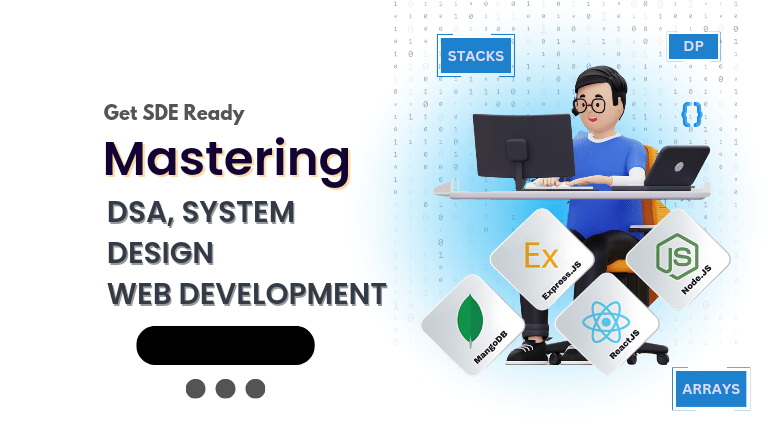
Fast-Track to Full Spectrum Software Engineering
- 120+ Live Classes & Recordings
- 24*7 Live Doubt Support
- 400+ DSA Practice Questions
- Comprehensive Notes
- HackerRank Tests & Quizzes
- 12+ live Projects & Deployments
- Case Studies
- Access to Global Peer Community
Buy for 51% OFF
₹35,000.00 ₹16,999.00
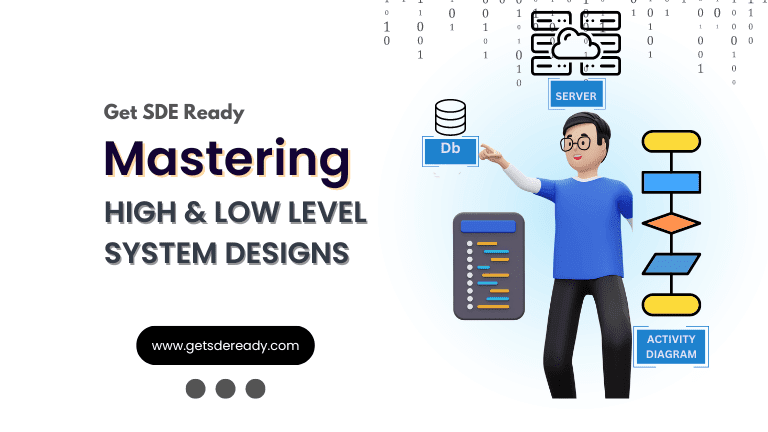
Low & High Level System Design
- 20+ Live Classes & Recordings
- 24*7 Live Doubt Support
- Case Studies
- Comprehensive Notes
- HackerRank Tests
- Topic-wise Quizzes
- Access to Global Peer Community
- Interview Prep Material
Buy for 60% OFF
₹20,000.00 ₹7,999.00
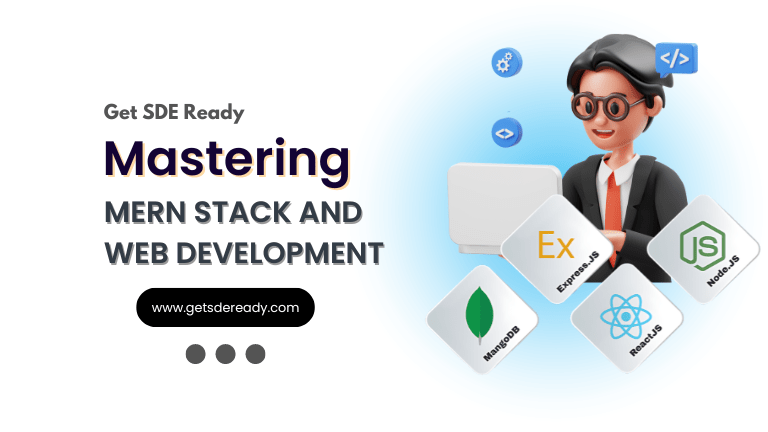
Mastering Mern Stack (WEB DEVELOPMENT)
- 65+ Live Classes & Recordings
- 24*7 Live Doubt Support
- 12+ Hands-on Live Projects & Deployments
- Comprehensive Notes & Quizzes
- Real-world Tools & Technologies
- Access to Global Peer Community
- Interview Prep Material
- Placement Assistance
Buy for 53% OFF
₹15,000.00 ₹6,999.00
Reach Out Now
If you have any queries, please fill out this form. We will surely reach out to you.
Contact Email
Reach us at the following email address.
arun@getsdeready.com
Phone Number
You can reach us by phone as well.
+91-97737 28034
Our Location
Rohini, Sector-3, Delhi-110085
